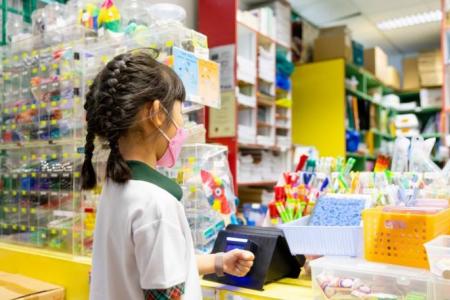All schools will have cashless payment scheme by 2025
Do not worry if you have forgotten to give your children school pocket money for the day.
More students will be able to use smartwatches to make cashless payments at their school canteen and bookshop, as well as selected retailers, with the expansion of a tap-and-pay programme.
The Ministry of Education (MOE) and POSB said on Wednesday (April 13) that the bank's POSB Smart Buddy programme will be extended to all primary and secondary schools, junior colleges and Millennia Institute by 2025.
Currently, Smart Buddy, which was launched by DBS-run POSB in 2017 in 19 primary schools, is tapped by about 80 primary and secondary schools. In three years' time, this number is expected to increase to around 340.
There are about 40,000 students on board now.
Smart Buddy, which is free for parents and students, aims to educate students on money management basics and help parents monitor their children's daily expenses, including setting spending limits.
The programme allows students to use a free Smart Buddy smartwatch or card linked to their parents' bank account to make cashless payments. This is done by tapping the smartwatch or card against compatible payment terminals, such as the ones POSB is installing in schools.
These school terminals can also accept other payments such as those made with ez-link cards and school smart cards, which are stored value cards that let card holders pay concessionary travel fares.
The tap-and-pay transactions using the Smart Buddy watches and cards can be made at retailers such as Cheers, Popular, FairPrice and 7-Eleven that accept Nets contactless payments as well.
Parents can monitor how much their children spend via the Smart Buddy watch or card in school and outside by using the free Smart Buddy mobile app for Android or iOS. They can also set savings goals and daily spending limits.
Payments made by students using ez-link and school smart cards in school can also be monitored, but those made outside are not tracked.
If their children have smartphones, parents can install the app on the devices and allow their kids to check how much they have spent.
Students can also check the balance in their smartwatch and cards by tapping them against a balance reader that POSB is installing in schools.

Mr Clarence Tang, divisional director of MOE's finance and procurement division, said "having a cashless option... will provide students with an environment to use e-payment safely while enjoying the convenience and benefits of going cashless".
Mr Jeremy Soo, DBS Bank's managing director and head of consumer banking group for Singapore, said that through the partnership with MOE to expand Smart Buddy, "we aim to give every student the option to familiarise themselves with using digital payments in their everyday lives, while learning how to cultivate prudent saving and spending habits".
"We believe these skills will provide a solid foundation for achieving financial wellness when they transition to the next stage of their lives," he added.
On improvements to Smart Buddy over the years, Mr Soo said the application process for the programme has been automated and parents need just less than a minute to complete an application online.
"We are also working on a next-generation smartwatch with improved features, such as a better user interface," he added.

An online survey by POSB last year of more than 600 parents found that more than 65 per cent of respondents said Smart Buddy helped their children save and manage their expenses better.
More than 70 per cent of the parents found that the programme is a useful tool to help educate their children about savings and expenditure.
Over 90 per cent of the respondents added that it is important for their children to be familiar with using digital tools as the world becomes increasingly digitalised.
For Xishan Primary School in Yishun, which rolled out Smart Buddy at the beginning of the year, the contactless payments have ensured faster and more hygienic transactions at the canteen and bookstore, said principal Anne Quek.
"Another benefit for parents is the convenience of topping up their children's allowance remotely if they have forgotten to do so earlier," she added.
Get The New Paper on your phone with the free TNP app. Download from the Apple App Store or Google Play Store now



